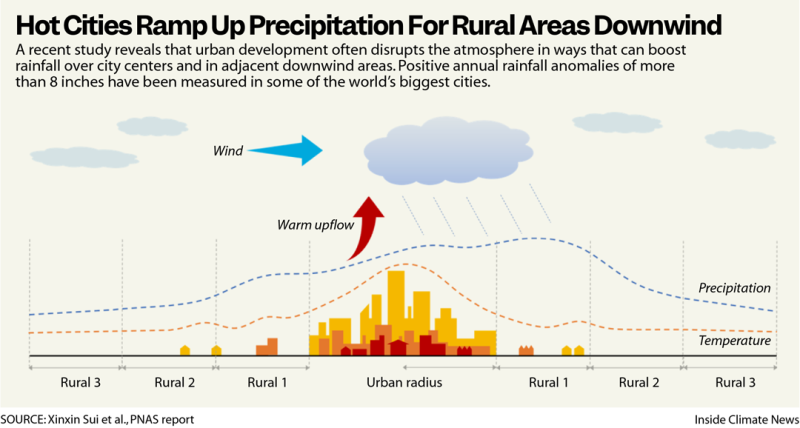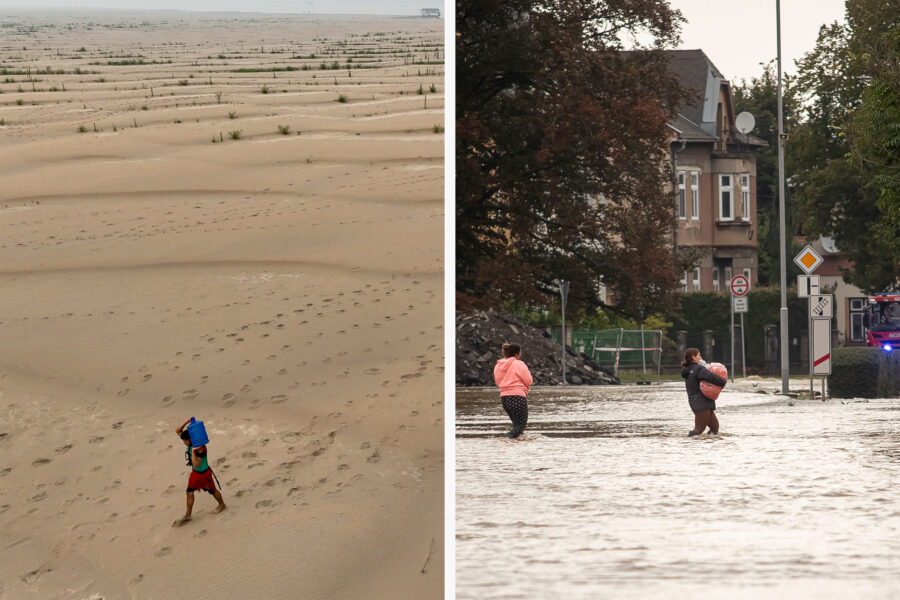Big Cities Disrupt the Atmosphere, Often Generating More Rainfall, But Can Also Have a Drying Effect
The world’s largest urban areas have an outsized influence on regional weather and climate patterns, often creating “wet islands,” with more rainfall over cities and adjacent downwind areas, according to a study published Monday in the Proceedings of the National Academy of Sciences.
The NASA-funded research used satellite data to measure rainfall in and around the world’s most populated cities 1,056 cities from 2001 to 2020, finding that 63 percent of them received more annual precipitation in and downwind of their urban areas, compared to bordering rural areas.
Cities affect regional weather and climate because they change the temperature and texture of the terrain, which affects how air flows over the land, and because they produce clouds of tiny pollution particles called aerosols, which can come from a variety of sources including industrial emissions, car exhaust and even trees, that can produce either more or less rain, depending on their exact chemical makeup.
Explore the latest news about what’s at stake for the climate during this election season.
Basically, as moist air flows over cities, the heat rising off paved areas like bubbles in a lava lamp, combined with the turbulence created by tall buildings, pushes the moisture upward where, potentially seeded by aerosol pollution, it can condense and fall to the surface as rain in greater amounts than over nearby undeveloped areas.
For example, Houston, on average, receives almost 5 inches more rain per year than its surrounding rural areas. In addition to Houston, cities with the largest precipitation anomalies include Ho Chi Minh City, Vietnam; Kuala Lumpur, Malaysia; Lagos, Nigeria; and the Miami-Fort Lauderdale-West Palm Beach metropolitan area.
But the research also documented a drying effect in 37 percent of the major cities it studied, including Seattle, where the effects of urban development and other factors have resulted in a nearly 8 inch negative annual precipitation anomaly, the biggest deficit measured in the study.
The researchers said negative rainfall anomalies typically occur in cities situated in valleys and lowlands, where nearby mountains exert a greater influence over precipitation than the urban footprint itself. The cities where this is most pronounced include Kyoto, Japan, and Jakarta, Indonesia.
But the global “wet island” signal is stronger, said co-author Dev Niyogi, a geoscientist at the University of Texas, Austin, who focuses on climate extremes and smart cities. The magnitude of the effect almost doubled during the 20-year study period, heightening concerns about dangerous urban flooding at a time when images of cars washing down city streets have become ubiquitous.
“The core of the finding is, cities are globally showing a signature of changing rainfall,” he said. “And just the way we consider urban heat islands as a global finding, the same way, I think this urban rainfall anomaly is a global feature. We have pretty good confidence in the robustness of the result.”

He said scientists have known about the urban rainfall anomaly for some time. “The uniqueness is in the global nature of this study, which is the first of its kind,” he said. It’s timely, he added, because the next major report from the Intergovernmental Panel on Climate Change, due in 2027, will focus on climate change and urban areas, where 55 percent of the world’s population lives, a proportion that is expected to increase to 70 percent by 2050.
“The use of satellite data to assess the impact of cities allows us to do this analysis worldwide, and cover all continents and climates,” a significant advancement in understanding how large-scale human development can affect weather and climate, said Valéry Masson, a researcher with the French National Center for Meteorological Research who was not involved in the study.
He said the study shows a link between city size and increased precipitation, “so larger cities in the future may have more impacts on precipitation.”
But he said that the link between increased precipitation and urban heat islands and aerosol loads appears to be statistical, “with no causal link shown. These two quantities are highly influenced by the size of the city … so these two processes may just be completely unconnected to precipitation increases,” he said, adding that more detailed studies would be needed to show a stronger link.
Adapting With Infrastructure and Planning
Regionally, African cities stood out as a group in the new study. Out of 17 cities with urban precipitation anomalies greater than 8 inches per year, nine are located in Africa. The fraction is much lower in Asia, but the greatest wet island effect, with positive rainfall anomalies of well more than 8 inches, were measured in two cities in that region: Ho Chi Minh City and Kuala Lumpur.

When Rio de Janeiro and Seattle emerged on the list of cities that have a big drying effect, Niyogi said it caught his attention because Rio had been in the news about nearly running out of water.
“To see that the city, in fact, has an impact on the rain itself made me think that if something is causing a change, and the change thus far is negative, then you could make that city different, to make that positive,” he said.
In either case, one option is to consider more widespread adoption of infrastructure that helps promote “sponge cities” that can absorb excess moisture and moderate flooding in wet times and provide water during dry spells, said lead author Xinxin Sui, a Ph.D. candidate at the University of Texas studying urban climate at the Cockrell School of Engineering.
“When it’s raining a lot, then the sponge can soak up this water, and then if there’s no rain for a long time, people can pump it out and use it,” she said. “Blue-green infrastructure is a quite popular concept, planting more trees and adding soil, rather than impervious pavement, so that water can infiltrate underground.”
In the bigger picture, Niyogi added, the study’s findings suggest that, in addition to making cities spongier, it’s time to start thinking about how their spatial design affects the weather and climate, and to integrate that knowledge into long-term planning.
The study found that population has the largest correlation with urban precipitation anomalies compared to other environmental and urbanization factors. This is because larger populations typically create denser and taller urban areas, along with more greenhouse gas emissions, and therefore more pronounced heat, Niyogi said.
“In the context of availability of water resources, or recharging water resources, we can think about creating rain, in a way, in places where it’s going to be important and where it can be stored,” he said.
That’s possible, he added, “By the way we design the city, by its shape, the amount of heat island mitigation, and whether it is a concentrated city or it is a sprawled out city.”
‘Where’s My Cloud?’
Global warming is also a key factor in the urban rainfall equation, simply because a warming atmosphere holds about 7 percent more moisture for every 1 degree Celsius of heating. And more warming also amplifies the urban heat island effect, which, in turn, intensifies the effect on rainfall in a climate feedback loop.
“We know the environment is much juicier,” Niyogi said. “It has more convection potential, and what cities are providing is the forcing that causes local instability, a trigger for rain.”
He describes this to his students as water-filled bubbles or balloons that are growing bigger, he said. “And now, all the kids sitting below are poking it. With just 10 kids, then maybe the probability of bursting the bubble is less. But if 30 of them are poking it, it is going to all come down.”
He said that, in some cases, cities may be concentrating rainfall that would have fallen over a larger area into a smaller space, which means a rainfall surplus in a given city might result in a rainfall deficit in nearby areas or other cities.
“I think once we go down the road where we recognize that cities are changing temperatures, that cities are changing rainfall,” he said, “I think it’s not very far-fetched to think, hey, where’s my cloud?”
Many cities still develop without looking at the regional impacts, and could benefit from more integrated regional planning, he said.
“I think it’s not very far-fetched to think, hey, where’s my cloud?”
“We have seen this in the manner in which cities study and respond to air pollution, where they have consortiums that are looking at it in a multi-city way,” he said. There might be an opportunity to think about water security in the same way, he said.
“More regional compacts about how cities get developed could be a possibility in coming decades, once we have an understanding that cities change rain,” he said. “How we use this to our advantage will depend on our technology, and on our willingness and ability to cooperate.”
Co-author Marshall Shepherd, a meteorologist and director of the atmospheric sciences department at the University of Georgia, said the research “shows the impact of urbanization can also change the climate, and it goes well beyond heat. Most people live in and around cities,” he said. “This work has established that the combined effects of anthropogenic emissions and land cover change amplifies flood risks.”
About This Story
Perhaps you noticed: This story, like all the news we publish, is free to read. That’s because Inside Climate News is a 501c3 nonprofit organization. We do not charge a subscription fee, lock our news behind a paywall, or clutter our website with ads. We make our news on climate and the environment freely available to you and anyone who wants it.
That’s not all. We also share our news for free with scores of other media organizations around the country. Many of them can’t afford to do environmental journalism of their own. We’ve built bureaus from coast to coast to report local stories, collaborate with local newsrooms and co-publish articles so that this vital work is shared as widely as possible.
Two of us launched ICN in 2007. Six years later we earned a Pulitzer Prize for National Reporting, and now we run the oldest and largest dedicated climate newsroom in the nation. We tell the story in all its complexity. We hold polluters accountable. We expose environmental injustice. We debunk misinformation. We scrutinize solutions and inspire action.
Donations from readers like you fund every aspect of what we do. If you don’t already, will you support our ongoing work, our reporting on the biggest crisis facing our planet, and help us reach even more readers in more places?
Please take a moment to make a tax-deductible donation. Every one of them makes a difference.
Thank you,
David Sassoon
Founder and Publisher
Vernon Loeb
Executive Editor
Share this article
Disclaimer: The copyright of this article belongs to the original author. Reposting this article is solely for the purpose of information dissemination and does not constitute any investment advice. If there is any infringement, please contact us immediately. We will make corrections or deletions as necessary. Thank you.








